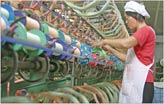Companies
US firm exports Chinese cutlery
Updated: 2011-06-15 13:34
By Kelly Chung Dawson (China Daily)
|
|
|
A chopsticks market stall. A factory in the US state of Georgia is producing 2 million chopsticks a day for export to China. [Photo/China Daily] |
As many as 10m chopsticks will be made in Georgia for sale in Asia markets
NEW YORK - For more than 3,000 years, chopsticks have been the quintessential Chinese dining tool. Now, millions of chopsticks are getting a "made in the United States" label, as a Georgia factory churns out utensils that will be exported to China.
The type of wood required for chopsticks - not too hard, not too soft - is scarce in China, but Southern Georgia is lush with both poplar and sweet gum trees, which are ideal. Most Chinese chopstick companies have traditionally imported wood from Russia and a few other countries to manufacture in China. But new Russian regulations against shipping raw lumber and rising freight prices have forced the industry to consider alternatives.
| ||||
But he got the idea to set up shop in the US after speaking with a friend in the chopstick business who was discouraged by increasing freight costs, he said in an interview with China Daily.
In November he opened Georgia Chopsticks in the town of Americus, Georgia, and is now producing 2 million chopsticks a day.
"China is the No 1 importer for raw materials," he said. "But it can be very expensive to ship materials, and some of the materials often get wasted in production. I realized that instead of sending logs, I could save money by producing somewhere else and then sending the products to China. Of course when a lot of labor needs to be done, you cannot beat Chinese prices. But when it's just basic work, it's worth it."
Lee said the wood is trimmed down to the basic shape of the chopsticks at the factory in Georgia. Then most of the company's wares are shipped to China, where they are polished and packaged in a Japanese-owned factory in Dalian. Some of the chopsticks are then sent to Japan and South Korea to be sold.
Since opening, the company has employed 25 workers and plans to hire at least 125 more to ultimately produce 10 million chopsticks a day, he said. This is great news for a town where unemployment is at 12 percent.
"This benefits both sides," Lee said. "I think more Chinese companies should look outside China, instead of just buying raw materials. Right now, we're the only chopstick company doing this. But I really think more Chinese companies should consider doing this in other areas too."
Specials

When two are one
After a separation of 360 years, Huang Gongwang's famous Dwelling in the Fuchun Mountains has been made whole again.

Wealth of difference
Rich coastal areas offer contrasting ways of dealing with country's development

Seal of approval
The dying tradition of seal engraving has now become a UNIVERSITY major



